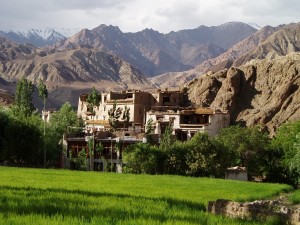 A scenic view of Triund Laka, Dharmashala
A scenic view of Triund Laka, Dharmashala
As I journey on with the twists and turns of the winding road, my mind keeps going back to Dharamsala, now left behind hidden in forests of pines which stand silent in dark shadows of the approaching darkness. Only a few persistent rays pierce through, rebelling against night setting in. Dharamsala like those rays, is a rebel with a cause. A cause so strong, it pulls thousands of tourists from all over the world. The spiritually starved tourists come to see if freedom has a price… if exile for the Tibetans is as lonely as each one of these tourists feels when among his own people.
Memories flash across my mindscape…
The exodus
…
I am poring over an issue of Contact, a community magazine run by an American in McLeod Ganj. My introduction to Dharmasala over a tall glass of hot honeyed cider with cinnamon peppering. I realize that at the foundation of Dharamsala, are a people who fled the Chinese occupation of their country, Tibet, led by their religious leader, His Holiness the 14th Dalai Lama. He chose Dharamsala to establish a refugee community in India in 1959. A perfect surrounding for the pursuit of the individual Buddha within. Over the years, the Free Tibet movement developed strong roots and Dharamsala became the Little Lhasa. It is maybe for this very reason that every stranger visiting this recreation of a life and culture, feels an uncanny sense of belonging.
The evidence that Dharamshala was once an abode of the sahibs and memsahibs is reflected in the proud demeanor of St. John in the Wilderness. Derelict and forlorn with its broken stain glass windows, the church stands ever naked to the onslaught of one-day excursions carried out by the umpteen travel agencies in Delhi. While further ahead is Dharamkot, the testament to the Brahmannical era that is almost obscured by time. Dating back to 635 A.D., the Chinese monk-pilgrim, Hsuan Tsang had recorded fifty monasteries with around 2, 000 monks in this fertile region.
Storm in a tea cup
…
I am walking down the streets, through the alleys and lanes of McLeod Ganj… soaking in every ray of sunlight to warm those cold bones. The inns and handicraft stores with their bright colored warmth dispel the numbness, making the morning forget the gloom and bone chilling discomfort of the night.
I enter a restaurant. The usual mélange of nationalities. Israel to Italy to New Zealand. Glasses of tea and joints dangling from their fingers passionately, predictably discussing world politics with a bit of newly gained spiritual understanding and philosophy. Nonchalantly swigging rum while sizing up the Indian walking in.
I walk over to a table thinking of hot noodles with vegetables and some tea. The waiter (also owner) rushes with, “Yaha Khana nahi milta”! My own fumbled Hindi as well as the sudden declaration dazes me. Did I understand wrong or did he mean that his is a restaurant that wouldn’t serve me without even asking me what I want? Stunned, I stumble back in the bright sunlight. Anger seethes and suddenly all of Mcleodganj is a traitor to me in my own land. I simmer thinking how a people who fight for freedom and respect from a tyrant can so disrespect people who have embraced them. “Its my land! How dare they?”, an evil voice swells up within and suddenly all the memories of shop-owners unwilling to show me wares and library which just disposed off books to foreigners refusing to even let me browse through, are awakened.


